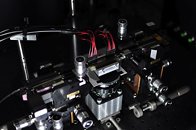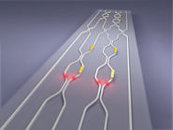qubit
Overclocked quantum bit
- Joined
- Dec 6, 2007
- Messages
- 17,865 (2.81/day)
- Location
- Quantum Well UK
| System Name | Quantumville™ |
|---|---|
| Processor | Intel Core i7-2700K @ 4GHz |
| Motherboard | Asus P8Z68-V PRO/GEN3 |
| Cooling | Noctua NH-D14 |
| Memory | 16GB (2 x 8GB Corsair Vengeance Black DDR3 PC3-12800 C9 1600MHz) |
| Video Card(s) | MSI RTX 2080 SUPER Gaming X Trio |
| Storage | Samsung 850 Pro 256GB | WD Black 4TB | WD Blue 6TB |
| Display(s) | ASUS ROG Strix XG27UQR (4K, 144Hz, G-SYNC compatible) | Asus MG28UQ (4K, 60Hz, FreeSync compatible) |
| Case | Cooler Master HAF 922 |
| Audio Device(s) | Creative Sound Blaster X-Fi Fatal1ty PCIe |
| Power Supply | Corsair AX1600i |
| Mouse | Microsoft Intellimouse Pro - Black Shadow |
| Keyboard | Yes |
| Software | Windows 10 Pro 64-bit |
A multi-purpose optical chip which generates, manipulates and measures entanglement and mixture - two quantum phenomena which are essential driving forces for tomorrow's quantum computers - has been developed by researchers from the University of Bristol's Centre for Quantum Photonics. This work represents an important step forward in the race to develop a quantum computer.
The fundamental resource that drives a quantum computer is entanglement - the connection between two distant particles which Einstein famously called 'spooky action at a distance'. The Bristol researchers have, for the first time, shown that this remarkable phenomenon can be generated, manipulated and measured entirely on a tiny silica chip. They have also used the same chip to measure mixture - an often unwanted effect from the environment, but a phenomenon which can now be controlled and used to characterize quantum circuits, as well as being of fundamental interest to physicists.


"In order to build a quantum computer, we not only need to be able to control complex phenomena such as entanglement and mixture, but we need to be able to do this on a chip, so that we can scalably and practically duplicate many such miniature circuits - in much the same way as the modern computers we have today," says Professor Jeremy O'Brien, Director of the Centre for Quantum Photonics. "Our device enables this and we believe it is a major step forward towards optical quantum computing."
The chip, which performs several experiments that would each ordinarily be carried out on an optical bench the size of a large dining table, is 70 mm by 3 mm. It consists of a network of tiny channels which guide, manipulate and interact single photons - particles of light. Using eight reconfigurable electrodes embedded in the circuit, photon pairs can be manipulated and entangled, producing any possible entangled state of two photons or any mixed state of one photon.
"It isn't ideal if your quantum computer can only perform a single specific task", explains Peter Shadbolt, lead author of the study, which is published in the journal Nature Photonics. "We would prefer to have a reconfigurable device which can perform a broad variety of tasks, much like our desktop PCs today - this reconfigurable ability is what we have now demonstrated. This device is approximately ten times more complex than previous experiments using this technology. It's exciting because we can perform many different experiments in a very straightforward way, using a single reconfigurable chip."
The researchers, who have been developing quantum photonic chips for the past six years, are now working on scaling up the complexity of this device, and see this technology as the building block for the quantum computers of the future.
Dr Terry Rudolph from Imperial College in London, UK, believes this work is a significant advance. He said: "Being able to generate, manipulate and measure entanglement on a chip is an awesome achievement. Not only is it a key step towards the many quantum technologies - such as optical quantum computing - which are going to revolutionize our lives, it gives us much more opportunity to explore and play with some of the very weird quantum phenomena we still struggle to wrap our minds around. They have made it so easy to dial up in seconds an experiment that used to take us months, that I'm wondering if even I can run my own experiment now!"
Paper
'Generating, manipulating and measuring entanglement and mixture with a reconfigurable photonic circuit' by P. J. Shadbolt, M. R. Verde, A. Peruzzo, A. Politi, A. Laing, M. Lobino, J. C. F. Matthews, M. G. Thompson and J. L. O'Brien in Nature Photonics
University of Bristol
View at TechPowerUp Main Site
The fundamental resource that drives a quantum computer is entanglement - the connection between two distant particles which Einstein famously called 'spooky action at a distance'. The Bristol researchers have, for the first time, shown that this remarkable phenomenon can be generated, manipulated and measured entirely on a tiny silica chip. They have also used the same chip to measure mixture - an often unwanted effect from the environment, but a phenomenon which can now be controlled and used to characterize quantum circuits, as well as being of fundamental interest to physicists.


"In order to build a quantum computer, we not only need to be able to control complex phenomena such as entanglement and mixture, but we need to be able to do this on a chip, so that we can scalably and practically duplicate many such miniature circuits - in much the same way as the modern computers we have today," says Professor Jeremy O'Brien, Director of the Centre for Quantum Photonics. "Our device enables this and we believe it is a major step forward towards optical quantum computing."
The chip, which performs several experiments that would each ordinarily be carried out on an optical bench the size of a large dining table, is 70 mm by 3 mm. It consists of a network of tiny channels which guide, manipulate and interact single photons - particles of light. Using eight reconfigurable electrodes embedded in the circuit, photon pairs can be manipulated and entangled, producing any possible entangled state of two photons or any mixed state of one photon.
"It isn't ideal if your quantum computer can only perform a single specific task", explains Peter Shadbolt, lead author of the study, which is published in the journal Nature Photonics. "We would prefer to have a reconfigurable device which can perform a broad variety of tasks, much like our desktop PCs today - this reconfigurable ability is what we have now demonstrated. This device is approximately ten times more complex than previous experiments using this technology. It's exciting because we can perform many different experiments in a very straightforward way, using a single reconfigurable chip."
The researchers, who have been developing quantum photonic chips for the past six years, are now working on scaling up the complexity of this device, and see this technology as the building block for the quantum computers of the future.
Dr Terry Rudolph from Imperial College in London, UK, believes this work is a significant advance. He said: "Being able to generate, manipulate and measure entanglement on a chip is an awesome achievement. Not only is it a key step towards the many quantum technologies - such as optical quantum computing - which are going to revolutionize our lives, it gives us much more opportunity to explore and play with some of the very weird quantum phenomena we still struggle to wrap our minds around. They have made it so easy to dial up in seconds an experiment that used to take us months, that I'm wondering if even I can run my own experiment now!"
Paper
'Generating, manipulating and measuring entanglement and mixture with a reconfigurable photonic circuit' by P. J. Shadbolt, M. R. Verde, A. Peruzzo, A. Politi, A. Laing, M. Lobino, J. C. F. Matthews, M. G. Thompson and J. L. O'Brien in Nature Photonics
University of Bristol
View at TechPowerUp Main Site
Last edited:

